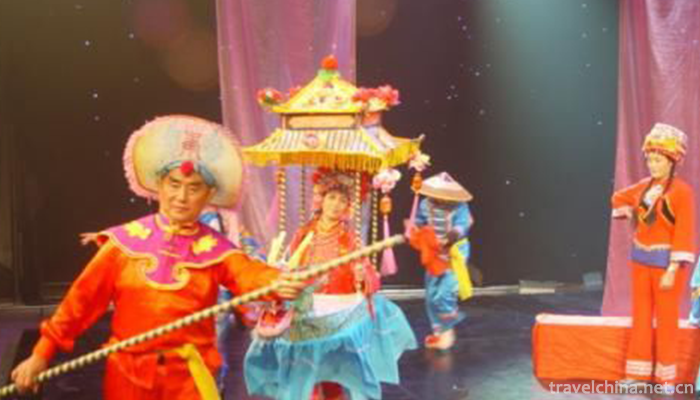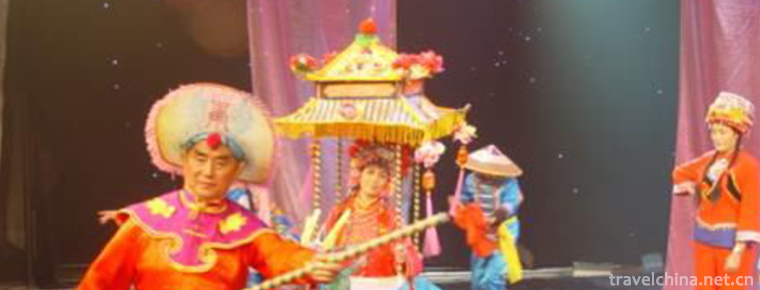Lichuan lantern song
Lichuan lantern song
Lichuan Lantern Song is a traditional folk dance that originated in Baiyang area of Lichuan City. Many folk songs in Lichuan Lantern Song and the ancient bamboo branch song inherit in one continuous line, which have high national cultural and artistic value. It has been recorded that from the Qing Dynasty, the masses sang lanterns and songs during the festivals, festive gatherings and dragon boats.
On May 23, 2011, Lichuan Lantern Song was approved by the State Council to be included in the third batch of national intangible cultural heritage list.
Historical evolution
Lichuan Lantern Song is an ancient folk song, which began in the early Qing Dynasty and has a history of more than 300 years. As the saying goes, "Thirty nights of fire, fifteen nights of light," Lichuan lantern songs and the Spring Festival customs are closely related. From the Qing Dynasty to the Republic of China, Lichuan people's custom of playing with lanterns rose widely, which was a collective recreational activity between festivals. Performers also dress up, commonly known as "lamp show", which has a little dramatic flavor.
After the founding of New China, the lanterns playing immortals and ghosts and a large number of lanterns singing about love were cancelled, but the Dragon lanterns, lions and lotus boats and car lights in the "last eight" and "miscellaneous lanterns" survived. In the Cultural Revolution, the lamp song stopped. Since the reform and opening up, although the performance of lotus boats and car lights has long lost its former brilliance, its performance time has gradually expanded from the New Year to all festive gatherings and leisure, from a custom to a popular cultural singing and dancing activities that can be carried out at any time.
artistic characteristics
Lichuan Lantern Song is a folk singing form of the Tujia people in Lichuan, which carries songs, dances and paddles the floor for the festivals and festivals, mainly with the dragon boats as props.
Representative works
"Dragon Boat Tune" is the representative work of Lichuan Lantern Song. Lichuan Lantern Song is the mother of "Dragon Boat Tune". Dragon Boat Tune, also known as Lantern Tune, Flower Lantern, Seed Melon Tune and Melon Seed Ren Tune, is a tune sung by the masses during the festival when they are rowing for lotus boats, and is a genuine Lichuan folk song.
In February 1956, Zhou Xuqing and Huang Yewei, cadres of Lichuan County Cultural Museum, collected seed melon tunes in Boyang and named them Dragon Boat Tunes. In March 1957, Wang Guosheng and Zhang Shuntang, peasant singers of Wangying Town, sang Dragon Boat Tune at the 2nd National Folk Music and Dance Competition held in Beijing, which won unanimous praise. In May 1962, "Dragon Boat Diao" was included in "Hubei Folk Songs Collection", which was released by the Central People's Radio Station. In 1979, Dragon Boat Tune was included in the Collection of Chinese Folk Songs. In recent decades, "Dragon Boat Tune" has landed on CCTV and the world stage many times. Wang Jieshi, Cheris, Wei Jindong, Meng Pigeon, Zhang Ye, Tang Can and other famous singers have sung one after another, with their charm and influence expanding. China's manned spacecraft also took it into space when it went into space. In 2004, Song Zuying sang a song "Dragon Boat Tune" in the Golden Hall of Vienna, which caused a sensation in the world music circle.
"Dragon Boat Tune" is only one of Lichuan's lamp songs, and "Dragon Boat Tune" is also mainly due to the collection and collation of the people's singing, so it is very famous. There are many representative works of Lichuan Lantern Songs, such as "Singing Mountain Songs for Lovers" and "Closing Eyes on a Sieve" which belong to the category of Lichuan Lantern Songs.
Inheritance significance
Lichuan is a treasure house of folk songs and dances, as well as national folk culture. There are many excellent national cultures waiting to be further excavated and sorted out. What is left behind by cultural heritage is not always good. We must learn to make the past serve the present, discard the dross and retain its essence, so that our cultural elements of national culture will continue to flourish.


-
1.Hakka stuffed tofu
Hakka-brewed tofu, also known as minced meat-brewed tofu and Dongjiang-brewed tofu, is one of Hakka's famous dishes and is said to be related to...
Time 2018-11-02 -
2.Wuxi film and television base
The Wuxi Film and Television Base of CCTV was originally built by CCTV to shoot "Tang Ming Huang", "Romance of the Three Kingdoms" and "Water Margin"
Time 2018-12-06 -
3.Fang te tourist area
Fang te tourist area is elaborately built by Huaqiang Fontewen Technology Group. It is a comprehensive leisure tourism resort integrating theme parks
Time 2018-12-08 -
4.Xiangshui lake the Great Wall
Xiangshui Lake is another unique and beautiful tourist attraction in the suburbs of Beijing. Located in the west of the Great Wall of Huairou Mutianyu
Time 2018-12-10 -
5.Daweishan National Forest Park
Dawei Mountain is located in the boundary between Hunan and Jiangxi Province, the hinterland of Lianyun Mountains, the East is Tonggu County under the jurisdiction of Yichun City, Jiangxi Province
Time 2019-01-07 -
6.Weiyang Palace Site in Changan City Han Dynasty
The site of Weiyang Palace in Chang'an City of Han Dynasty, located in the southwestern part of the site of Weiyang District, Xi'an City, Shaanxi Province, was built in the seventh year of Han Gaozu (
Time 2019-01-13 -
7.Zhijin cave
Zhijin Cave, located in Guanzhai Miao Township, Zhijin County, Guizhou Province, is located on the South Bank of Liuchong River, one of the sources of Wujiang River, 120 kilometers away from Guiyang,
Time 2019-03-18 -
8.The Firing Techniques of Jun Porcelain
Jun porcelain firing technology, Yuzhou City, Henan Province, traditional handicraft, one of the national intangible cultural heritage.
Time 2019-05-08 -
9.Qingxu Caimen Building
Qingxu Caimen Tower is a local traditional handicraft in Qingxu County, Shanxi Province. Xu Caimen Tower in Qing Dynasty is said to have originated in Tang Dynasty. During the festival, people gathere
Time 2019-06-11 -
10.Shandong drum
In addition to the book drum, the musical instruments of Shandong drum were initially beaten with two pieces of plough and plough, and then two pieces of iron and copper were used, accompanied by thre
Time 2019-06-13 -
11.Tsinghua University
The campus of Tsinghua University is situated in northwest Beijing on the site of the former imperial gardens of the Qing Dynasty, and surrounded by a number of historical sites.
Time 2019-08-31 -
12.Longchi National Forest Park
Longchi National Forest Park is located in Dujiangyan City, Sichuan Province. It is only 84 kilometers away from Chengdu and 30 kilometers away from Dujiangyan. It is one of the 20 key national forest parks in China.
Time 2020-11-05